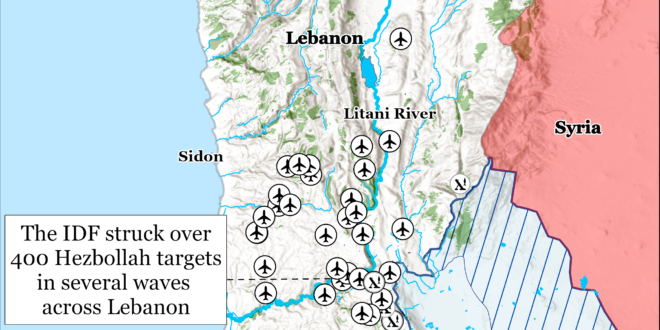The Israel Defense Forces (IDF) conducted a large-scale airstrike campaign across Lebanon on September 21 and 22.[i] The IDF announced on September 21 that it targeted over 400 rocket launchers, thousands of rocket barrels, and other military infrastructure in at least two waves of airstrikes across southern Lebanon.[ii] An Israeli military correspondent reported that the strikes targeted short- and medium- range rocket launchers within firing range of Haifa and other northern Israeli towns.[iii] The IDF stated that it was responding to indications that Hezbollah was preparing to launch rockets into northern Israel.[iv] The IDF announced new security protocols for some of the northern communities around the same time in response to the indications of an imminent Hezbollah attack.[v]
The IDF announced on September 22 that it conducted another wave of airstrikes targeting dozens of Hezbollah rocket launchers and military infrastructure across Lebanon.[vi] The IDF framed the most recent wave of strikes as meant to degrade Hezbollah forces rather than to preempt an imminent Hezbollah attack, as was the case for the previous day’s airstrikes.[vii] The framing that the IDF offered for the most recent wave of strikes matches generally how the IDF has discussed most of its airstrikes into Lebanon since October 2023.
This activity marks the third consecutive day of heavy Israeli airstrikes into Lebanon.[viii] This activity also comes immediately after Israel detonated thousands of Hezbollah pagers and personal radios on September 18 and 19, respectively. IDF Chief of Staff Lieutenant General Herzi Halevi said that Israel will continue to target Hezbollah with ”blow after blow” until Israel achieves its stated war aim of allowing displaced citizens to return to their homes in northern Israel.[ix]
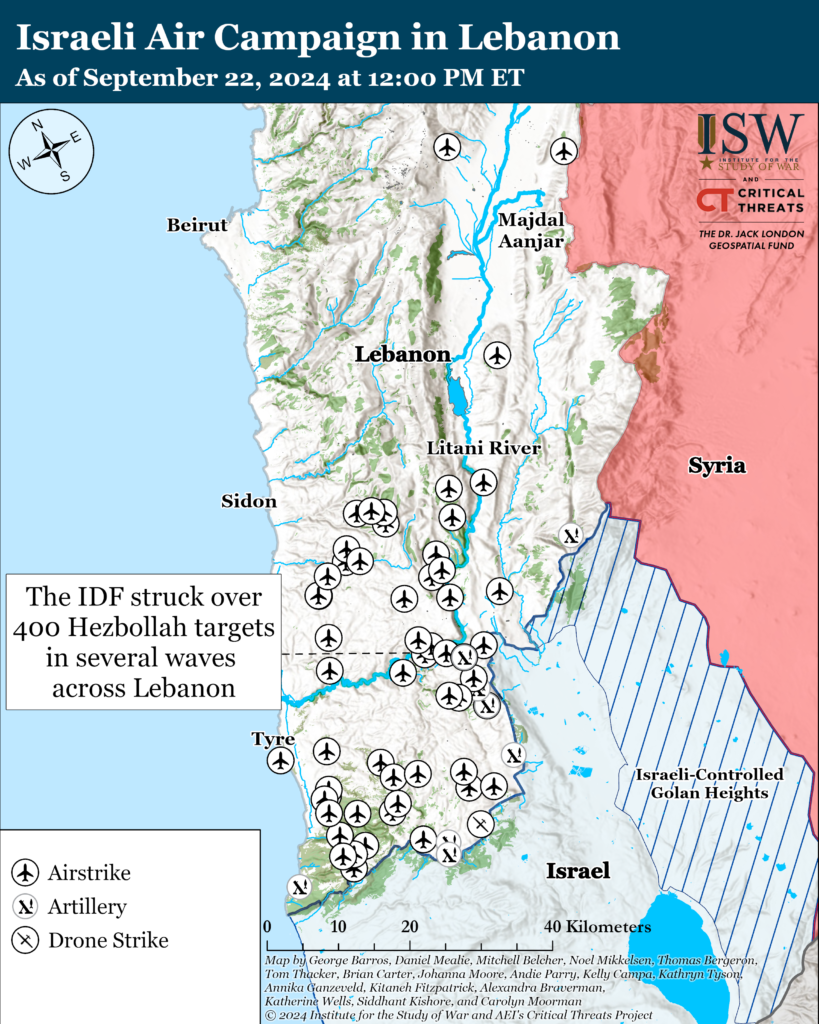
This map illustrates the locations of Israeli air and artillery strikes based on local Lebanese reporting. This map depicts strikes reported from 12:00pm ET on September 21 to 12:00pm ET on September 22. This map is not exhaustive. CTP-ISW cannot independently verify the locations of Israeli strikes.
Hezbollah launched its own strikes into Israel on September 21 and 22. These attacks are consistent with Hezbollah Secretary General Hassan Nasrallah declaring recently that the group would continue its cross-border attacks in support of Hamas in the Gaza Strip.[x] Hezbollah launched three barrages of medium-range rockets targeting IDF Ramat David airbase in northern Israel on September 21.[xi] The airbase is the northernmost one in Israel. Hezbollah stated that the attack was in response to “repeated Israeli attacks” on Lebanon.[xii] The IDF intercepted about 24 rockets.[xiii] This attack may have been the one that the IDF preempted earlier that day.
Hezbollah fired around another 85 short- and medium-range rockets targeting Rafael Advanced Defense Systems near Haifa on September 22.[xiv] The Rafael Advanced Defense Systems is an Israeli defense company that develops weapons and military technology, including the Iron Dome air defense system, for the IDF.[xv] Hezbollah claimed that it targeted the company’s site in retaliation for Israel detonating Hezbollah pagers and personal radios.[xvi] Several rockets impacted areas just outside Haifa and injured three people.[xvii]
It is notable that these latest Hezbollah attacks are slightly smaller in scale than previous retaliatory attacks the group has conducted. Hezbollah fired between 200 and 300 projectiles, including around 20 one-way attack drones, on August 24 in retaliation to Israel killing top Hezbollah commander Fuad Shukr.[xviii]
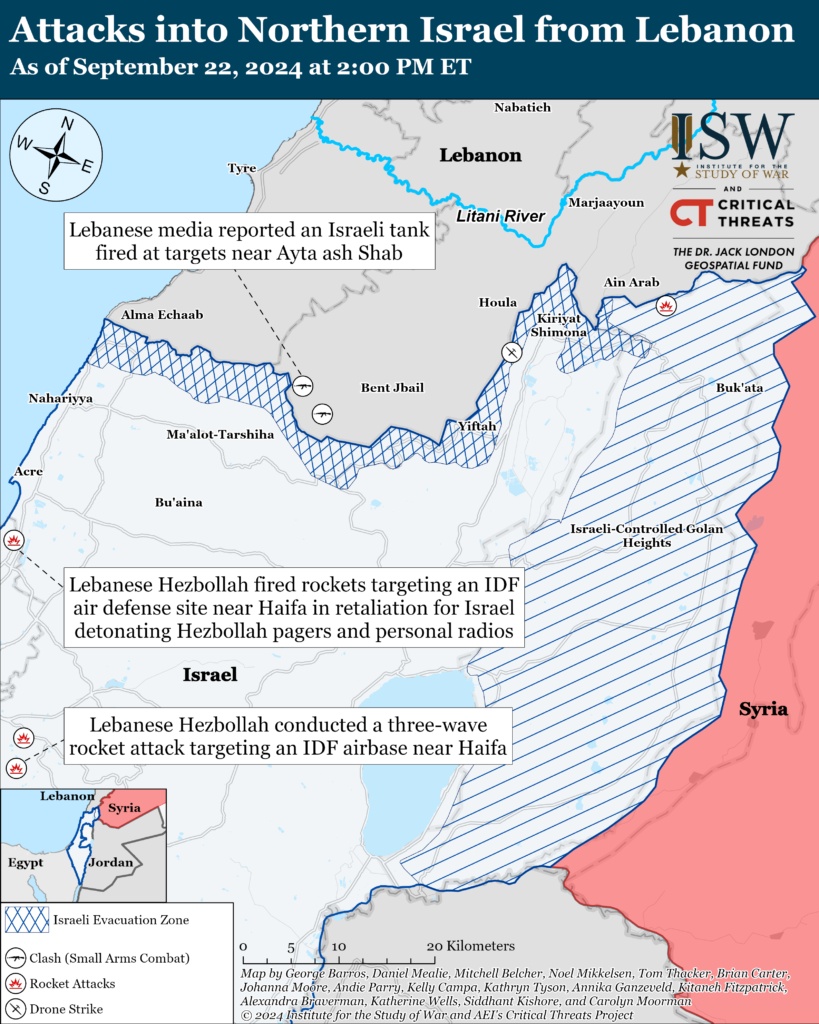
The Islamic Resistance in Iraq—a coalition of Iranian-backed Iraqi militias—claimed five attacks into Israel on September 22. The claims included the following:
An Arqab cruise missile attack targeting an unspecified location in northern Israel[xix]
A drone attack targeting an unspecified “vital target” in Israel[xx]
A drone attack targeting an unspecified location in southern Israel[xxi]
An Arfad drone attack targeting an unspecified location in the Jordan Valley[xxii]
A drone attack targeting an unspecified location in the Jordan Valley[xxiii]
The IDF intercepted two cruise missiles that were headed toward the southern Golan Heights from Iraq.[xxiv] The IDF intercepted the missiles before they entered Israeli airspace. The IDF also intercepted a drone that was heading toward southern Israel from Iraq.[xxv] The IDF intercepted the drone before it entered Israeli airspace, but air sirens still activated near Eilat. The IDF lastly intercepted a drone that flew over the southern Golan Heights from the east.[xxvi]
The commander of the IDF 7th Armored Brigade, Colonel Elad Zuri, published a letter on September 20 in which he said that the brigade is prepared to be the first unit to “lead the IDF in the northern arena.”[xxvii] Zuri said that the 7th Brigade is deployed on the northern border and prepared to fight in order to return displaced northern residents to their homes.[xxviii] The IDF separately deployed the 98th Division, including the 35th Paratroopers and 89th Commando brigades, to northern Israel on September 18.[xxix] The 7th Brigade most recently fought in the Gaza Strip on August 30 under the command of the 98th Division.[xxx] It is unclear whether the 7th Brigade deployed north as part of the 98th Division or whether it will be subordinate to the 36th Division in Israel’s Northern Command.
Key Takeaways:
Lebanon: The IDF conducted a large-scale air campaign into Lebanon. This activity marks three consecutive days of heavy Israeli airstrikes into Lebanon.
Lebanon: Lebanese Hezbollah launched its own strikes into Israel, which is consistent with Hezbollah’s stated intent to continue cross-border attacks.
Iraq: The Islamic Resistance in Iraq claimed five attacks into Israel. The IDF intercepted several drones and cruise missiles headed toward Israel from Iraq.
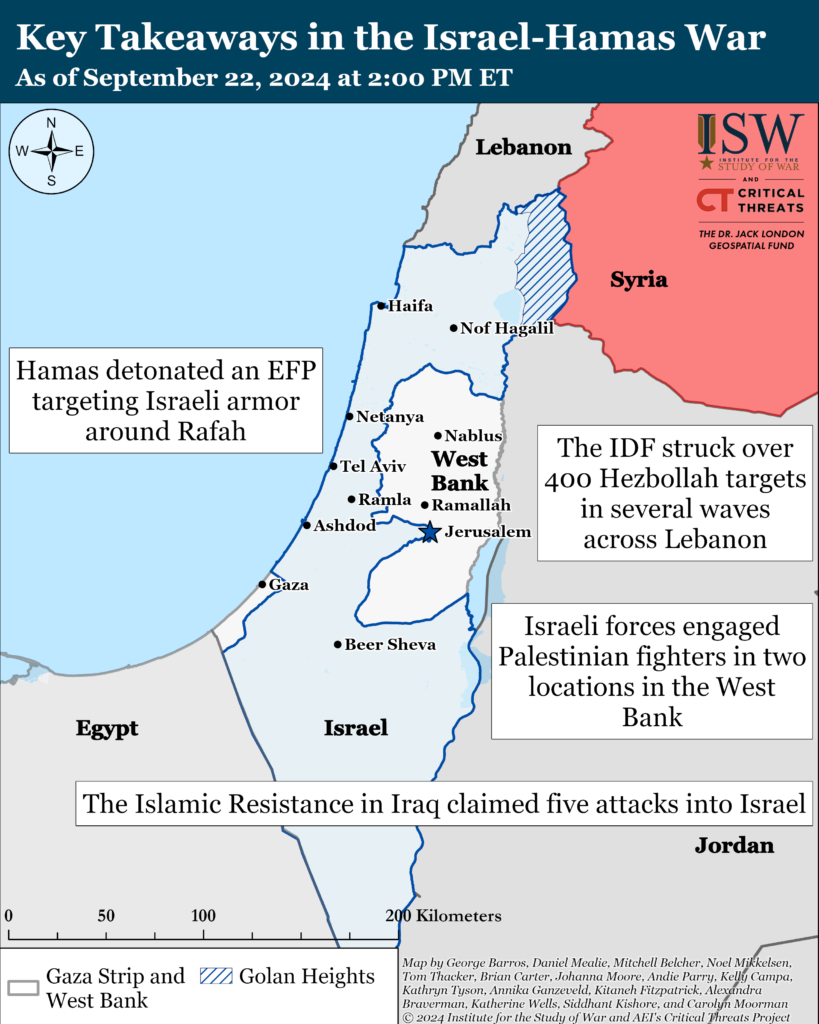
Gaza Strip
Axis of Resistance objectives:
Erode the will of the Israeli political establishment and public to sustain clearing operations in the Gaza Strip
Reestablish Hamas as the governing authority in the Gaza Strip
The IDF Air Force conducted an airstrike targeting Hamas fighters in a former school in al Shati refugee camp, Gaza City on September 22.[xxxi] The IDF reported that it targeted Hamas fighters in the Kafr Qasim school.[xxxii] The IDF added that it took steps to minimize civilian casualties in the airstrike, including using certain munitions and aerial surveillance.[xxxiii]
Hamas conducted multiple attacks targeting Israeli forces east of Rafah City on September 21.[xxxiv] Hamas fighters detonated an explosively formed penetrator (EFP) targeting an Israeli tank in the al Shawka area.[xxxv] This attack does not indicate, however, that Hamas’ Rafah Brigade is operating as an effective military unit. CTP-ISW previously assessed that even severely degraded military formations, such as Hamas’ Rafah Brigade, can continue to conduct simple opportunistic attacks.[xxxvi] Hamas separately fired tandem-charge munitions targeting an IDF bulldozer and detonated an improvised explosive device (IED) targeting IDF soldiers in al Shawka.[xxxvii]
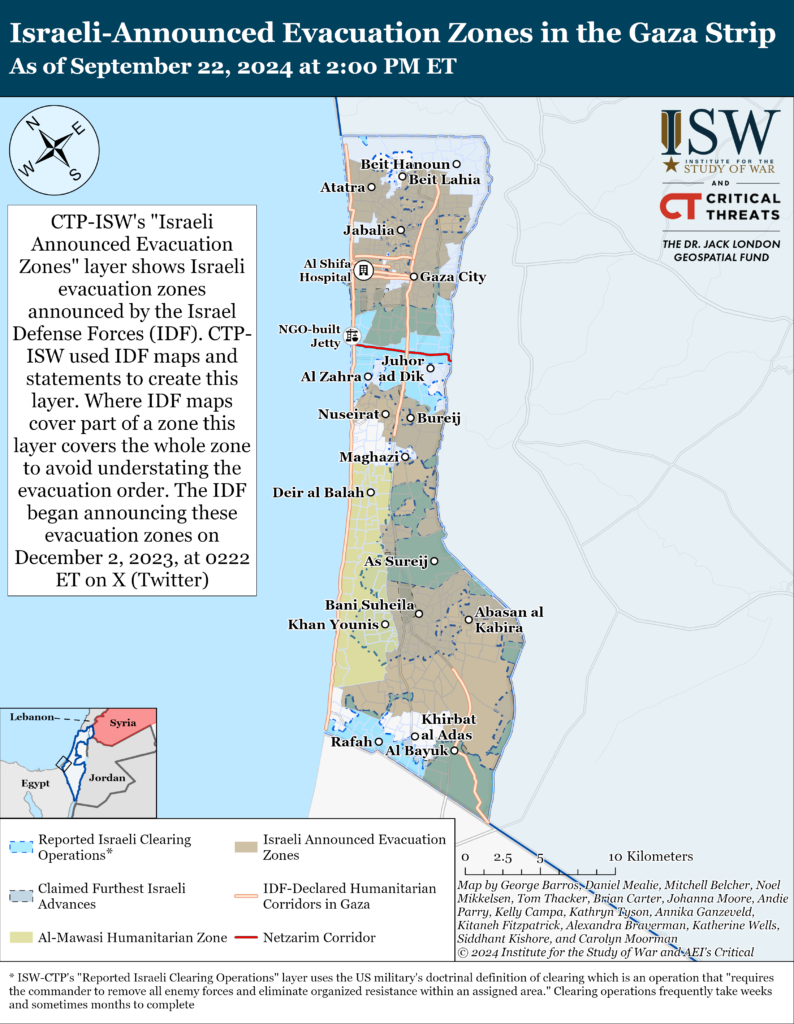
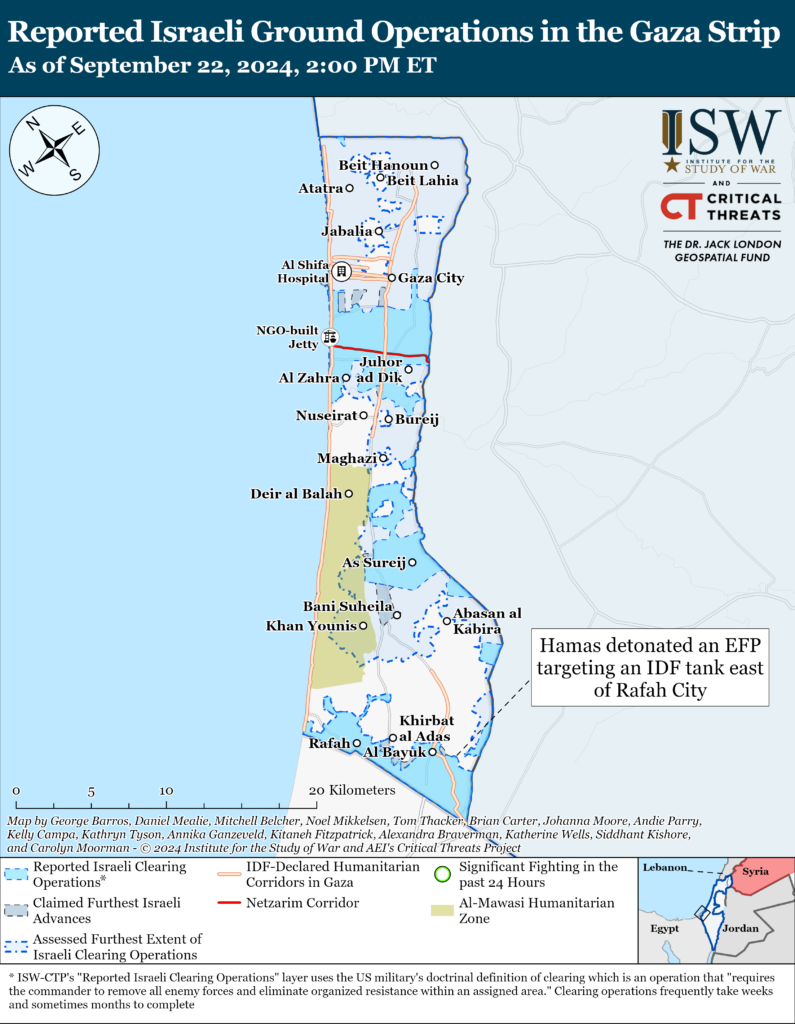
West Bank
Axis of Resistance objectives:
Establish the West Bank as a viable front against Israel
Israeli forces have engaged Palestinian fighters in at least two locations in the West Bank since CTP-ISW’s last data cutoff on September 21.[xxxviii] The al Aqsa Martyrs’ Brigades fired small arms and detonated IEDs targeting Israeli forces in Nablus and Tubas.[xxxix]
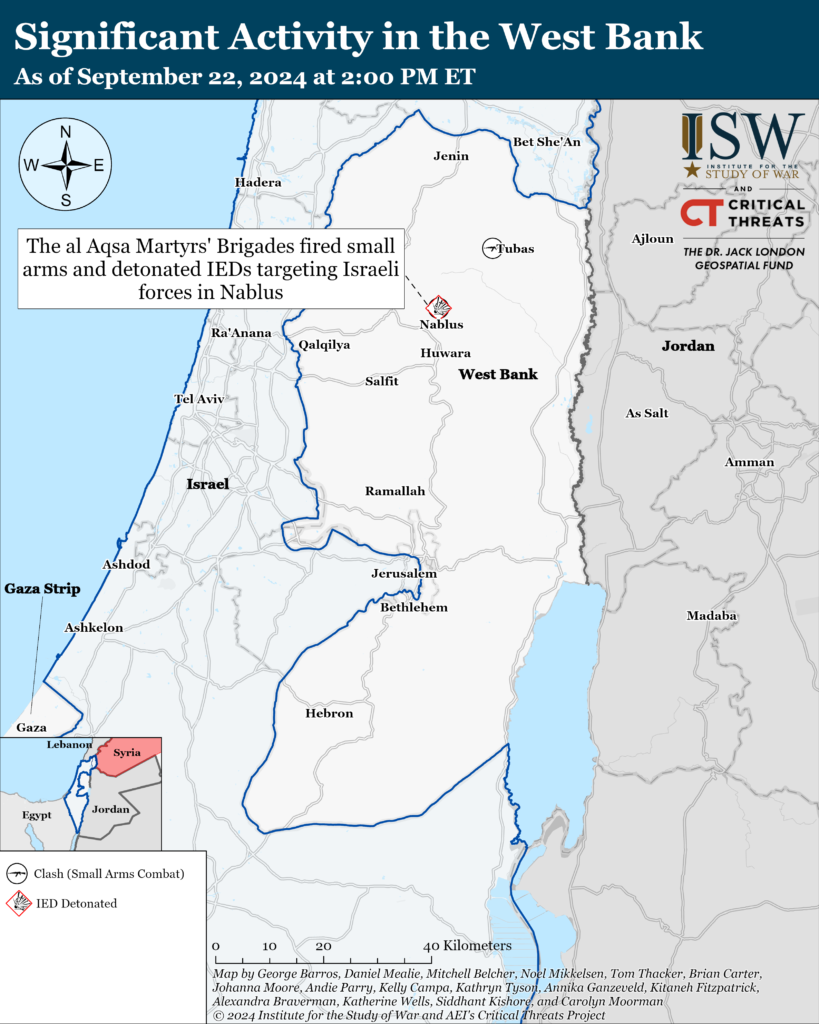
This map is not an exhaustive depiction of clashes and demonstrations in the West Bank.
Southern Lebanon and Golan Heights
Axis of Resistance objectives:
Deter Israel from conducting a ground operation into Lebanon
Prepare for an expanded and protracted conflict with Israel in the near term
Expel the United States from Syria
Lebanese Hezbollah has conducted at least four attacks into northern Israel since CTP-ISW’s last data cutoff on September 21, including the attacks targeting Ramat David Airbase and the Rafael Advanced Defense Systems site.[xl] These attacks are described above.
 Eurasia Press & News
Eurasia Press & News
